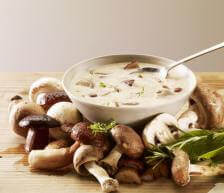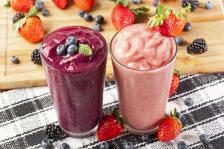Healthy Options for Soft or Liquid Diets
How do you get the nutrition you need (and flavors you crave) when you can only eat soft or liquid foods? Nutrition Diva shares her tips.
Monica Reinagel, MS, LD/N, CNS
Listen
Healthy Options for Soft or Liquid Diets
Nutrition Diva listener Marcia writes, “My husband will be having major dental reconstruction soon, starting with the extraction of several molars. He is going to need a soft diet for a while. Would a liquid nutritional drink like Ensure or Boost be a good idea…or should I just lay in lots of ice cream?”.
Anyone undergoing major dental surgery deserves lots of sympathy…and at least one milkshake. But if this ordeal will be going on for more than just a few days, something a little more nutritious will also be required.
Shortly after I received Marcia’s email, I happened to walk by a display of one of the “complete” nutrition drinks she mentioned in the grocery store. Sadly, the brand’s nutrition details were not very impressive: made from water, corn syrup, milk protein concentrate, and vegetable oil, each serving provides 10 grams of protein, 28 grams of sugar and 0 grams of fiber. Frankly, you’d be better off drinking chocolate milk–it’s got almost as much protein, not as much sugar, and at least a couple of grams of fiber! (I bet it tastes better, too.)
As for the 26 vitamins and minerals provided by this drink, if you were to take the cheapest drugstore brand one-a-day vitamin you could find, cut it in thirds, and dissolve it in your milk, you’d be ahead of the game. Marcia, I think we can do considerably better–using actual food.
 Nutritious Options for a Liquid Diet
Nutritious Options for a Liquid Diet
-
Smoothies. After the initial sympathy milkshake, switch over to smoothies as a more nutritious option. See also: How to Make the Perfect Smoothie
-
Milk. For those who tolerate dairy products, a glass of milk provides 8 grams of protein, plenty of calcium, potassium, and B12, and makes a convenient and nutritious between-meal snack. See also: Is Milk Bad for You?
-
Kefir or Drinkable Yogurt. A cultured milk product, such as kefir or drinkable yogurt, supplies the same nutrients as milk, plus the added benefits of probiotic bacteria. See also: Fermented and Cultured Foods
-
Vegetable Juice. Tomato juice or V8 offers some good vegetable nutrition without all the sugar of fruit juice. (Choose low sodium versions if sodium is a concern.) V8 is also tasty as a hot drink! See also: Juicing: Healthy Habit or Blood Sugar Bomb?
- Pureed Soups. Bisques or pureed soups are another way to add variety and nutrition to a liquid diet. You can make your own by simmering carrots, potatoes, broccoli, cauliflower, asparagus, or other seasonal vegetables in just enough chicken or vegetable stock to cover them. Spice it up with curry powder, ginger, garlic, onion, nutmeg, or fresh herbs. When the vegetables are tender, use an immersion blender to puree until silky. Blend in a dollop of sour cream, a few slices of avocado, silken tofu, or yogurt to add creaminess and extra nutrition. Cold soups, such as gazpacho or cucumber yogurt soup, can be whirred together without the need for any cooking.
How to Add Variety to a Liquid Diet
Liquid diets can quickly become monotonous. To keep things interesting, rather than making one giant batch of soup, make several smaller batches so that you can more easily vary the flavors. Alternate between cold and hot, sweet, spicy, and savory. For your smoothies, mix things up with a few different kinds of frozen fruit. Even varying the colors of your meals and snacks can help keep appetites (and moods) from sagging.
Finally, for those who are accustomed to eating a lot of grains, the sudden switch to a liquid diet may cause constipation. Consider taking a fiber supplement (such as psyllium husk) along with plenty of water, to keep things moving.
Nutritious Options for a “Soft” Diet

All of the things on a liquid diet can be enjoyed on a soft diet, In addition, you can add:
-
Eggs. Soft scrambled eggs are a great way to boost protein intake. See also: Which Eggs are Best?
-
Cooked cereal. Hot cereal is a good way to start getting more fiber. Forget the nubby steel cut oats and go for smoother oat bran or wheatena. See also: Ask the Diva: What’s Even Better Than Oatmeal?
-
Fresh cheeses. Try topping soft cheeses such as cottage cheese, quark, or ricotta cheese with stewed fruit. (Stewed rhubarb and fresh ricotta make a particularly good combination.) See also: Ask the Diva: What Is Quark Cheese?
-
Pureed vegetables. Use the same technique as you used for soups, but use a little less stock, to create a slightly stiffer puree that can be eaten with a fork or spoon. Try pureed butternut squash, carrots, celery root or turnips, and creamed spinach or Swiss chard. See also: A Cheap and Easy Way to Wash Your Vegetables
-
Soups. As a step up from fully pureed soups, try split pea or cream of mushroom soup. See also: Creamy Mushroom Soup
-
Soft and/or minced meat. Although steak and barbequed chicken aren’t on the menu yet, softer options–such as poached fish–should be fine. Finely minced or shredded meat–such as ham or tuna salad–would also be OK. (Just leave out the celery for now.) See also: What’s the Healthiest Kind of Tuna?
- Soft fruit. Canteloupe or honeydew melon, bananas, mango or very ripe pears are also good options for a soft diet.
Dental surgery is no fun, but in my opinion, serving up over-sweetened, liquid nutrition supplements just add insult to injury. As you can see, there are lots of ways to enjoy real food–and good nutrition–through a straw. Here’s hoping for a speedy recovery!
Smoothies and soup images courtesy of Shutterstock

 Nutritious Options for a Liquid Diet
Nutritious Options for a Liquid Diet